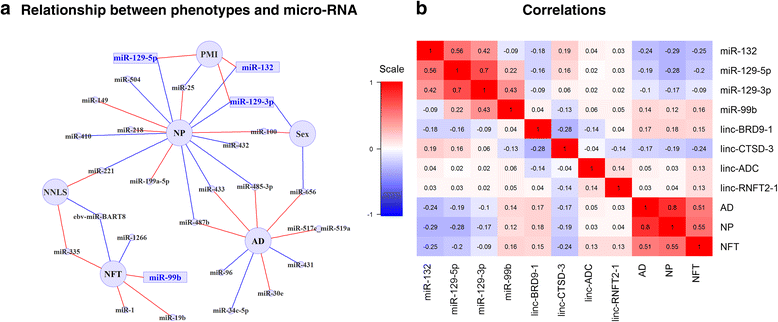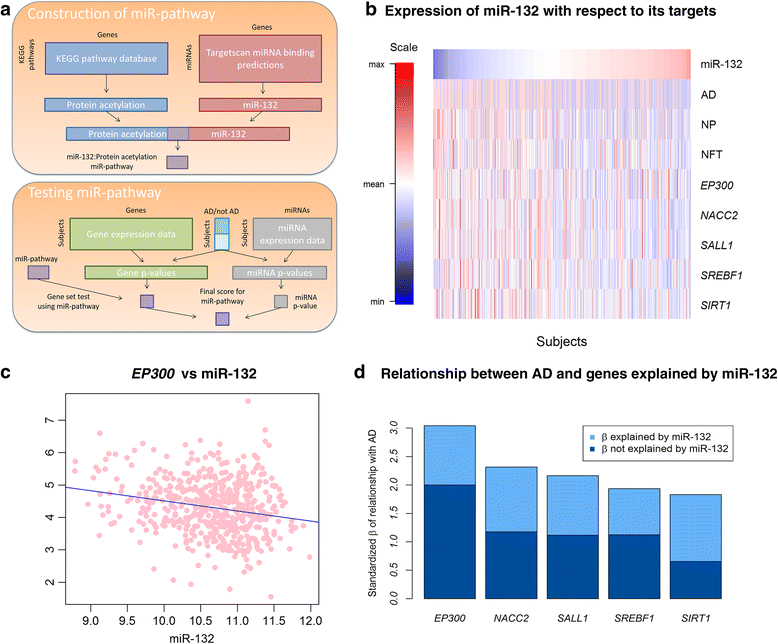Dissecting the role of non-coding RNAs in the accumulation of amyloid and tau neuropathologies in Alzheimer's disease
- PMID: 28668092
- PMCID: PMC5494142
- DOI: 10.1186/s13024-017-0191-y
Dissecting the role of non-coding RNAs in the accumulation of amyloid and tau neuropathologies in Alzheimer's disease
Abstract
Background: Given multiple studies of brain microRNA (miRNA) in relation to Alzheimer's disease (AD) with few consistent results and the heterogeneity of this disease, the objective of this study was to explore their mechanism by evaluating their relation to different elements of Alzheimer's disease pathology, confounding factors and mRNA expression data from the same subjects in the same brain region.
Methods: We report analyses of expression profiling of miRNA (n = 700 subjects) and lincRNA (n = 540 subjects) from the dorsolateral prefrontal cortex of individuals participating in two longitudinal cohort studies of aging.
Results: We confirm the association of two well-established miRNA (miR-132, miR-129) with pathologic AD in our dataset and then further characterize this association in terms of its component neuritic β-amyloid plaques and neurofibrillary tangle pathologies. Additionally, we identify one new miRNA (miR-99) and four lincRNA that are associated with these traits. Many other previously reported associations of microRNA with AD are associated with the confounders quantified in our longitudinal cohort. Finally, by performing analyses integrating both miRNA and RNA sequence data from the same individuals (525 samples), we characterize the impact of AD associated miRNA on human brain expression: we show that the effects of miR-132 and miR-129-5b converge on certain genes such as EP300 and find a role for miR200 and its target genes in AD using an integrated miRNA/mRNA analysis.
Conclusions: Overall, miRNAs play a modest role in human AD, but we observe robust evidence that a small number of miRNAs are responsible for specific alterations in the cortical transcriptome that are associated with AD.
Keywords: Alzheimer’s disease; Neuritic β-amyloid plaques and neurofibrillary tangles; lincRNA; microRNA.
Conflict of interest statement
Ethics approval and consent to participate
The ROS and MAP studies were approved by the Institutional Review Board of Rush University Medical Center. All subjects have given written informed consent.
Consent for publication
Not applicable.
Competing interests
The authors declare that they have no competing interests.
Publisher’s Note
Springer Nature remains neutral with regard to jurisdictional claims in published maps and institutional affiliations.
Figures




Similar articles
-
Beneficial effect of human anti-amyloid-beta active immunization on neurite morphology and tau pathology.Brain. 2010 May;133(Pt 5):1312-27. doi: 10.1093/brain/awq056. Epub 2010 Mar 31. Brain. 2010. PMID: 20360050 Free PMC article. Clinical Trial.
-
MicroRNA-23b attenuates tau pathology and inhibits oxidative stress by targeting GnT-III in Alzheimer's disease.Neuropharmacology. 2021 Sep 15;196:108671. doi: 10.1016/j.neuropharm.2021.108671. Epub 2021 Jun 18. Neuropharmacology. 2021. PMID: 34153312
-
Diffuse Amyloid-β Plaques, Neurofibrillary Tangles, and the Impact of APOE in Elderly Persons' Brains Lacking Neuritic Amyloid Plaques.J Alzheimers Dis. 2018;64(4):1307-1324. doi: 10.3233/JAD-180514. J Alzheimers Dis. 2018. PMID: 30040735 Free PMC article.
-
MicroRNA in Alzheimer's disease revisited: implications for major neuropathological mechanisms.Rev Neurosci. 2018 Feb 23;29(2):161-182. doi: 10.1515/revneuro-2017-0042. Rev Neurosci. 2018. PMID: 28941357 Review.
-
Review on Alzheimer's disease: Inhibition of amyloid beta and tau tangle formation.Int J Biol Macromol. 2021 Jan 15;167:382-394. doi: 10.1016/j.ijbiomac.2020.11.192. Epub 2020 Dec 2. Int J Biol Macromol. 2021. PMID: 33278431 Review.
Cited by
-
miRNA-Dependent Control of Homeostatic Plasticity in Neurons.Front Cell Neurosci. 2019 Dec 5;13:536. doi: 10.3389/fncel.2019.00536. eCollection 2019. Front Cell Neurosci. 2019. PMID: 31866828 Free PMC article. Review.
-
Differential methylation of circRNA m6A in an APP/PS1 Alzheimer's disease mouse model.Mol Med Rep. 2023 Feb;27(2):55. doi: 10.3892/mmr.2023.12942. Epub 2023 Jan 20. Mol Med Rep. 2023. PMID: 36660942 Free PMC article.
-
Alterations in Striatal microRNA-mRNA Networks Contribute to Neuroinflammation in Multiple System Atrophy.Mol Neurobiol. 2019 Oct;56(10):7003-7021. doi: 10.1007/s12035-019-1577-3. Epub 2019 Apr 9. Mol Neurobiol. 2019. PMID: 30968343 Free PMC article.
-
Brain microRNAs associated with late-life depressive symptoms are also associated with cognitive trajectory and dementia.NPJ Genom Med. 2020 Feb 6;5:6. doi: 10.1038/s41525-019-0113-8. eCollection 2020. NPJ Genom Med. 2020. PMID: 32047652 Free PMC article.
-
Sex- and region-specific cortical and hippocampal whole genome transcriptome profiles from control and APP/PS1 Alzheimer's disease mice.PLoS One. 2024 Feb 7;19(2):e0296959. doi: 10.1371/journal.pone.0296959. eCollection 2024. PLoS One. 2024. PMID: 38324617 Free PMC article.
References
-
- Lambert JC, Ibrahim-Verbaas CA, Harold D, Naj AC, Sims R, Bellenguez C, DeStafano AL, Bis JC, Beecham GW, Grenier-Boley B, et al. Meta-analysis of 74,046 individuals identifies 11 new susceptibility loci for Alzheimer's disease. Nat Genet. 2013;45:1452–1458. doi: 10.1038/ng.2802. - DOI - PMC - PubMed
MeSH terms
Substances
Grants and funding
- RF1 AG015819/AG/NIA NIH HHS/United States
- R01 AG017917/AG/NIA NIH HHS/United States
- R01 AG032990/AG/NIA NIH HHS/United States
- RC2 AG036547/AG/NIA NIH HHS/United States
- U01 ES017155/ES/NIEHS NIH HHS/United States
- R01 AG018023/AG/NIA NIH HHS/United States
- RF1 AG036042/AG/NIA NIH HHS/United States
- U01 AG046152/AG/NIA NIH HHS/United States
- P50 AG016574/AG/NIA NIH HHS/United States
- K25 AG041906/AG/NIA NIH HHS/United States
- R01 AG036042/AG/NIA NIH HHS/United States
- P30 AG010161/AG/NIA NIH HHS/United States
- R01 AG036836/AG/NIA NIH HHS/United States
- R01 AG015819/AG/NIA NIH HHS/United States
LinkOut - more resources
Full Text Sources
Other Literature Sources
Medical
Miscellaneous

